- Home
- The Autumn Garden
- Autumn Color for Shrubs
Keep Autumn Color in Mind
When Choosing Shrubs
for Your Garden
Some of our favorite garden shrubs also exhibit marvelous autumn color. Don't miss this second opportunity to add color to your garden by choosing shrubs that will do double duty. For a shady area try bottlebrush buckeye for its white 'brushes' in spring followed by lovely yellow in fall, or oakleaf hydrangea for white trusses of bloom in spring and red to purple fall foliage colors. For a sunny location, try forsythia for its yellow bells in spring followed by yellow to burgundy fall color, and Judd's viburnum with its delightfully fragrant white clusters of bloom in spring and yellow-to-red-to-purple fall foliage (one of the latest to turn color).
Aesculus parvifolia, bottlebrush buckeye, Zones 4-8. Lovely autumn color for the woodland border from this large shrub or small tree. Turns a clear yellow in fall.
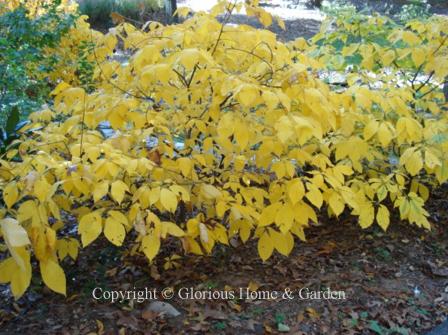 Aesculus parviflora
Aesculus parvifloraAsimina triloba, paw paw, Zones 5-8. Native to much of the eastern U.S., this shrub or small tree spreads via root suckers to form thickets and turns yellow-green-to-yellow in fall. Nice to use at the edge of a woodland or as a transition between formal and natural areas.
Berberis thunbergii ‘Orange Rocket,’ Japanese barberry, Zones 4-9. The new growth on this variety of Japanese barberry leafs out orange in the spring, turns green for summer, and then has a second season of bright color by turning red-orange to red in fall. If that weren’t enough, red berries adorn it in winter.
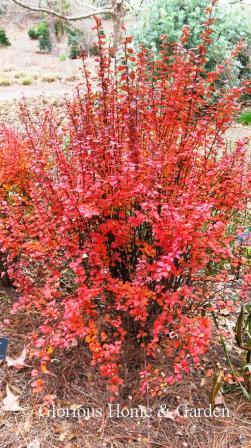 Berberis thunbergii 'Orange Rocket'
Berberis thunbergii 'Orange Rocket'Chimonanthus praecox, fragrant winterhazel, Zones 7-9. Lovely for late yellow fall color, soon followed by very fragrant pale yellow blooms from late December to February.
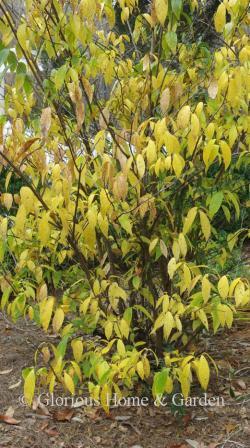 Chimonanthus praecox
Chimonanthus praecoxEdgeworthia chrysantha, paperbush, Zones 7-8. I love edgeworthia because it blooms from mid- February into March over several weeks and exudes a sweet fragrance that perfumes the entire garden. But, it has four seasons of interest. The bare branches of winter have a sculptural quality with large white buds that foretell the blooms to come. In spring and summer edgeworthia adorns itself with beautiful long blue-green leaves and always looks neat and tidy. Fall leaves turn a lovely soft yellow over several weeks, and they finally drop revealing the white buds at the tips of each branch.
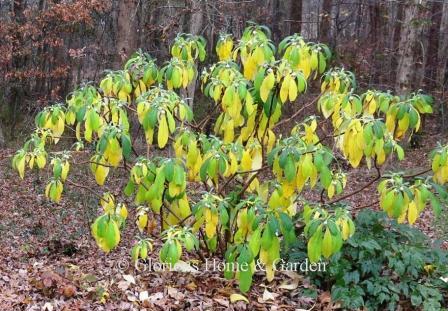 Edgeworthia chrysantha
Edgeworthia chrysanthaEnkianthus campanulatus, redvein enkianthus, Zones 5-7. Great autumn colors of orange, red and purple as can be seen on this specimen along with charming, dangling pink and cream fruits. This is one that is not much used in the South as it seems to prefer cooler temperatures.
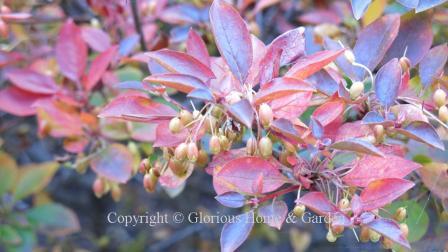 Enkianthus campanulatus fall leaves
Enkianthus campanulatus fall leavesEuonymus alatus, winged euonymus or burning bush, Zones 4-8. Turns brilliant deep cherry to dark red in autumn. One of the best shrubs for dependable red fall color.
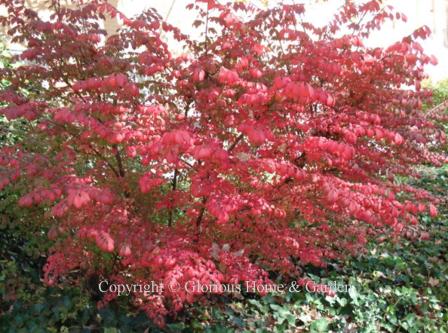 Euonymus alatus
Euonymus alatusForsythia x intermedia, forsythia or yellow bells, Zones 6-8. Can have autumn leaves in shades of yellow, maroon, burgundy --often at the same time--but not reliably every year.
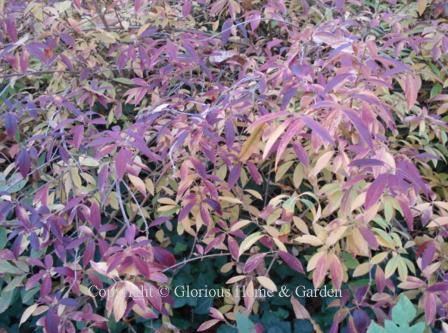 Forsythia x intermedia
Forsythia x intermediaFothergilla gardenii, dwarf fothergilla, Zones 5-8. Colorful autumn leaves can vary from yellow to orange to red, often appearing at the same time, but not always reliably. 'Mt. Airy' is a particularly dependable selection.
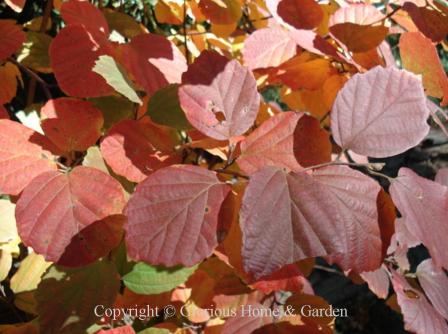 Fothergilla gardenii
Fothergilla gardeniiWitchhazels for Autumn Color
Hamamelis mollis, Chinese witchhazel, Zones 5-8. The beautiful golden autumn color on this shrub, plus the fragrant yellow flowers that occur in late winter/early spring makes it an outstanding accent in the landscape.
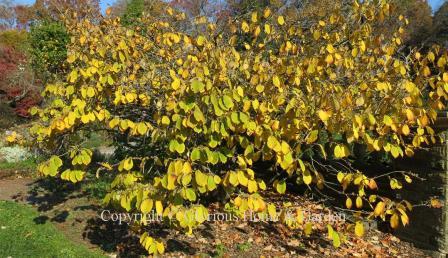 Hamamelis mollis 'Princeton Gold'
Hamamelis mollis 'Princeton Gold'Hamamelis x intermedia 'Diane,' hybrid witchhazel, Zones 5-8. This cultivar is a cross between Chinese (H. mollis) and Japanese (H. japonica). This one taken at the Daniel Stowe Botanical Garden in Belmont, N.C. in late October was blooming as the leaves turned golden.
Hamamelis x intermedia 'Jelena,' hybrid witchhazel, Zones 5-8. I am becoming more and more enamored of witchhazels. I love the fact that they bloom in late winter when not much else does and they often display beautiful autumn color like the coppery-red of 'Jelena.'
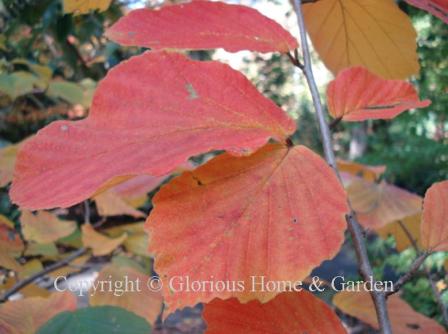 Hamamelis x intermedia 'Jelena'
Hamamelis x intermedia 'Jelena'Hamamelis x intermedia ‘Luna,’ hybrid witchhazel, Zones 5-8. I loved how this cultivar of witchhazel, ‘Luna,’ gradually changed color from green to yellow together with red margins.
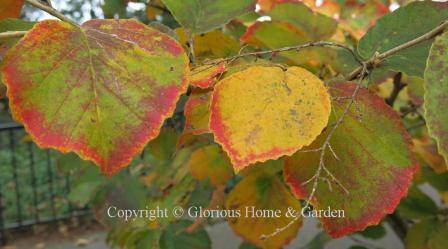 Hamamelis x intermedia 'Luna'
Hamamelis x intermedia 'Luna'Hamamelis vernalis, vernal witchhazel, Zones 4-8. This North American native shrub has outstanding golden fall color. Does best in full sun to part shade for best color. This species blooms in winter to early spring depending on location.
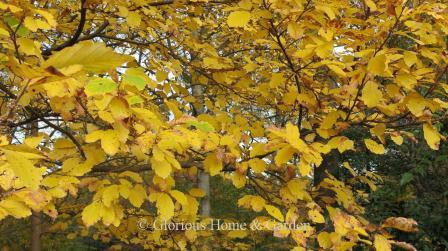 Hamamelis vernalis
Hamamelis vernalisHydrangea macrophylla, big leaf hydrangea, Zones 6-9. The big green leaves are slow to drop especially in a mild fall when the shrubs don’t seem to want to stop blooming, but eventually they begin turning yellow usually from the inside out—some may even turn purple in the right conditions.
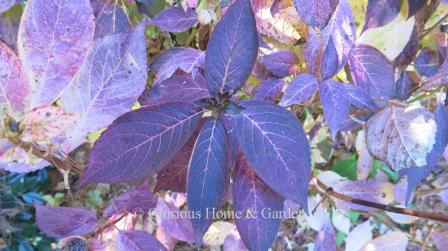 Hydrangea macrophylla lacecap in fall
Hydrangea macrophylla lacecap in fallHydrangea quercifolia, oakleaf hydrangea, Zones 5-9. Brilliant autumn color in oranges, reds and purples on this specimen on the University of Georgia campus in Athens.
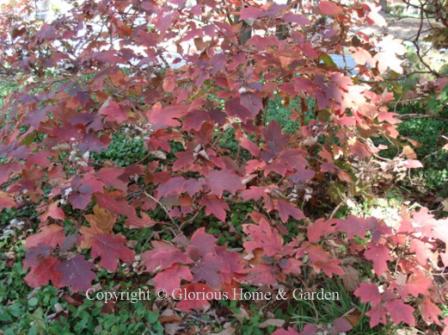 Hydrangea quercifolia
Hydrangea quercifoliaLindera angustifolia, Oriental or narrow-leaved spicebush, Zones 6-8. Need a bit of fall color for a semi-shady, moist (but well-drained) location? Oriental spicebush would be a good choice with its golden yellow-to-orange fall color and black fruits. The yellow spring flowers often appear before the leaves completely drop off.
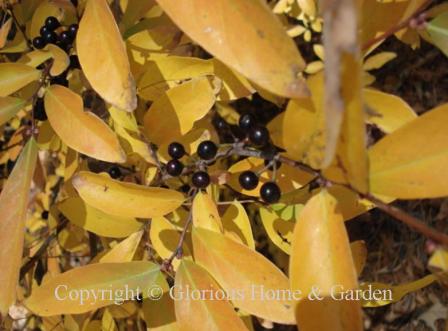 Lindera angustifolia
Lindera angustifoliaLindera benzoin, spicebush, Zones 4-9. This native North American shrub has brilliant clear yellow fall color. I love the way the leaves flutter in the breeze--always eye-catching!
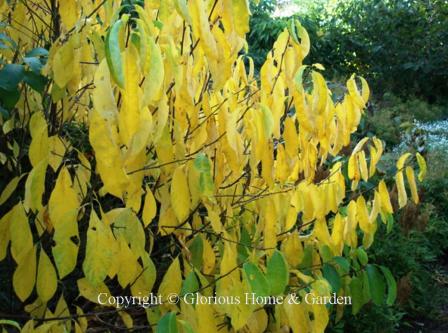 Lindera benzoin
Lindera benzoinRhododendron schlippenbachii, royal azalea, Zones 4-6. A gorgeous deciduous azalea for northern gardens. The leaves turn various shades of orange, red and yellow in the fall. This one at Asticou Azalea Garden, Mt. Desert Island, Maine.
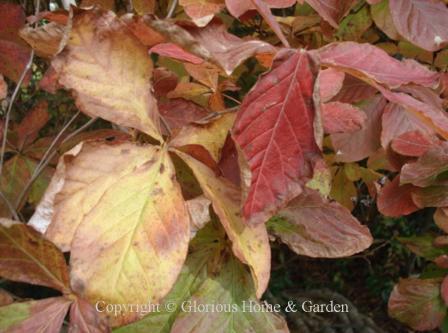 Rhododendron schlippenbachii
Rhododendron schlippenbachiiSpiraea japonica ‘Neon Flash,’ Japanese spirea, Zones 4-8. The cultivar ‘Neon Flash’ grows to a mound of about 3’ and turns gold in the fall.
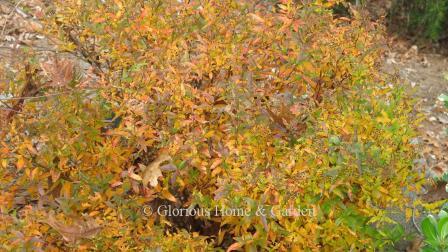 Spiraea japonica 'Neon Flash'
Spiraea japonica 'Neon Flash'Vaccinium ashei, rabbiteye blueberry, Zones 8-9. Blueberries not only produce delicious fruit, but they turn color beautifully in the fall as well.
Vaccinium corymbosum, highbush blueberry, Zones 3-7. Excellent fall color, great for hedges, shrub borders.
Viburnums for Autumn Color
Viburnum carlesii, Koreanspice viburnum, Zones 5-8. Late to turn, but brilliant, this specimen reached its peak in mid-December in my Zone 8a garden and turned all shades of yellows, oranges, deep reds and purples.
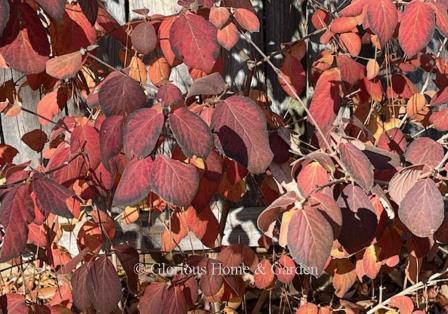 Viburnum carlesii
Viburnum carlesiiViburnum x juddii, Judd's viburnum, Zones 4-8. Excellent in all seasons from outstanding spring fragrance to brilliant autumn color.
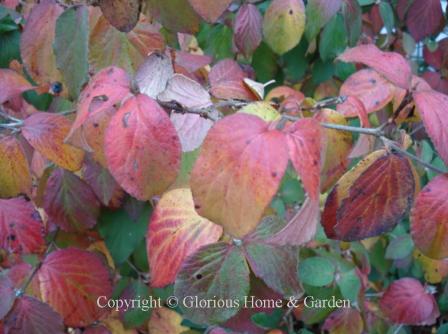 Viburnum x juddii
Viburnum x juddiiViburnum nudum, smooth witherod, Zones 5-9. Outstanding burgundy fall color on glossy, leathery leaves. Small blue fruits add to the decoration.
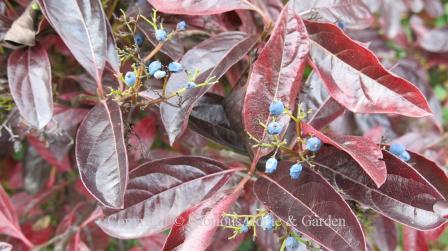 Viburnum nudum 'Winterthur'
Viburnum nudum 'Winterthur'Viburnum plicatum var. tomentosum, doublefile viburnum, Zones 5-7. This shrub is one of the most beautiful in the spring with its layers of pure white blooms, but it is also one the best for fall color. 'Shasta' is shown.
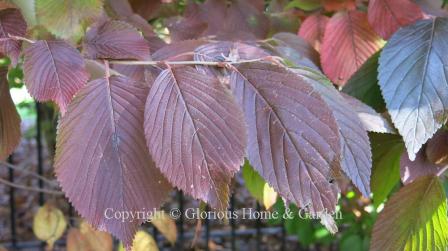 Viburnum plicatum var. tomentosum
Viburnum plicatum var. tomentosumWisteria floribunda, Japanese wisteria, Zones 5-9. I had to include these wisteria vines trained into tree forms from Longwood Gardens in Pennsylvania because they are so beautiful, and I didn’t know wisteria could turn such lovely yellow colors in fall.
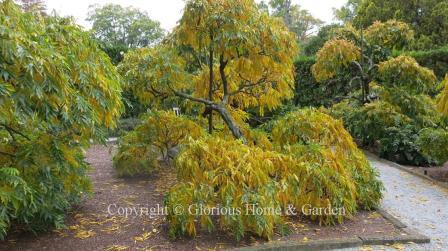 Wisteria floribunda 'Geisha'
Wisteria floribunda 'Geisha'Plant of the Month
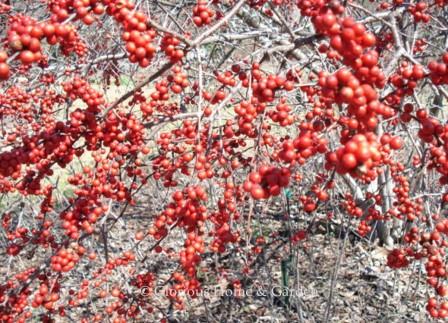
Ilex verticillata
Winterberry holly
Updated new USDA Plant Hardiness Zone Map 2023.